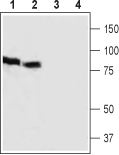Overview
- Peptide (C)ELEPRLDAEVYK, corresponding to amino acid residues 190-201 of rat HCN3 (Accession Q9JKA8). 2nd extracellular loop.

 Western blot analysis of rat (lanes 1 and 3) and mouse (lanes 2 and 4) brain lysates:1,2. Anti-HCN3 (extracellular) Antibody (#APC-083), (1:200).
Western blot analysis of rat (lanes 1 and 3) and mouse (lanes 2 and 4) brain lysates:1,2. Anti-HCN3 (extracellular) Antibody (#APC-083), (1:200).
3,4. Anti-HCN3 (extracellular) Antibody, preincubated with HCN3 (extracellular) Blocking Peptide (#BLP-PC083).
Note: Samples were heated to 37°C prior to loading on gel.
 Expression of HCN3 in rat U-87 MG cellsCell surface detection of HCN3 in intact living U-87 MG cells. A. Extracellular staining of cells using Anti-HCN3 (extracellular) Antibody (#APC-083), (1:25) followed by goat anti-rabbit-AlexaFluor-594 secondary antibody (red). B. Live view of the cells. C. Extracellular staining merged with live view of the cells.
Expression of HCN3 in rat U-87 MG cellsCell surface detection of HCN3 in intact living U-87 MG cells. A. Extracellular staining of cells using Anti-HCN3 (extracellular) Antibody (#APC-083), (1:25) followed by goat anti-rabbit-AlexaFluor-594 secondary antibody (red). B. Live view of the cells. C. Extracellular staining merged with live view of the cells.
- Much, B. et al (2003) J.Biol.Chem. 278, 43781.
- Notomi, T. and Shigemoto R. (2004) J. Comp. Neurol. 471, 241.
- Gravante, B. et al. (2004) J. Biol. Chem. 279, 43847.
Hyperpolarization-activated cation currents (Ih) appear in the heart and brain and play a crucial role in controlling electrical pacemaker activity, contributing to biological processes such as heartbeat, sleep-wake cycle and synaptic plasticity.1,2
The Ih currents are generated by the Hyperpolarization-activated cyclic nucleotide-gated channel family (HCN), which comprises of four homologous members, named HCN1-4. Each HCN subunit consist of six transmembrane domains (TM), a pore region between TM5-TM6 and a binding domain to cyclic nucleotides (CNBD) in the cytoplasmic C-terminus.2
The HCN subunits can form functional homomers and can also co-assemble into functionally heteromers.2
The channels are closely related to each other and share homology of about 60%. However, they differ from each other in their cytoplasmic N- and the C-terminus. HCN1-4 mainly differ from each other with regard to their speed of activation and the extent by which they are modulated by cAMP. HCN1 is the fastest channel, followed by HCN2, HCN3 and HCN4.2,3
The HCN3 channels are abundant in the brain where high expression of HCN3 mRNA was found in the hypothalamus.
Application key:
Species reactivity key:
Alomone Labs is pleased to offer a highly specific antibody directed against an epitope of rat HCN3. Anti-HCN3 (extracellular) Antibody (#APC-083) can be used western blot and live cell imaging applications. The antibody recognizes an extracellular epitope and is thus ideal for detecting the channel in living cells. It has been designed to recognize HCN3 from human, rat and mouse samples.
